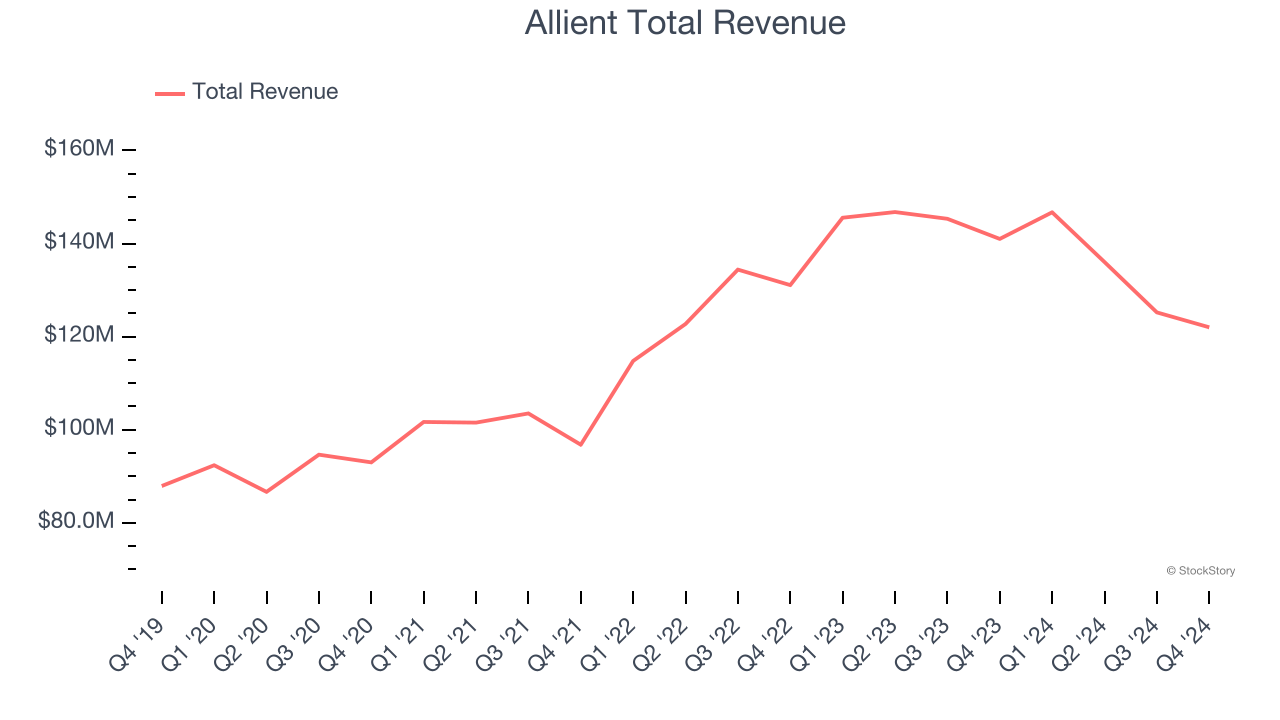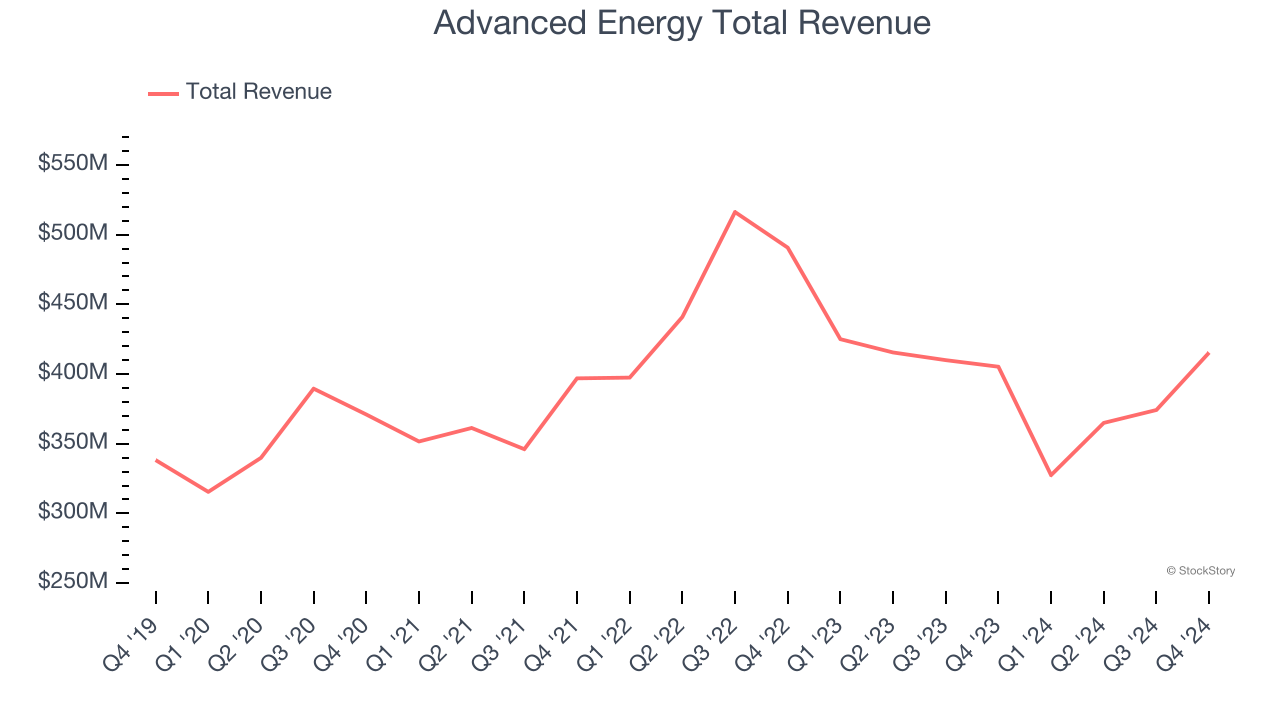
Looking back on electronic components stocks’ Q4 earnings, we examine this quarter’s best and worst performers, including Allient (NASDAQ: ALNT) and its peers.
Like many equipment and component manufacturers, electronic components companies are buoyed by secular trends such as connectivity and industrial automation. More specific pockets of strong demand include data centers and telecommunications, which can benefit companies whose optical and transceiver offerings fit those markets. But like the broader industrials sector, these companies are also at the whim of economic cycles. Consumer spending, for example, can greatly impact these companies’ volumes.
The 10 electronic components stocks we track reported a mixed Q4. As a group, revenues beat analysts’ consensus estimates by 3.1% while next quarter’s revenue guidance was 0.6% below.
Amidst this news, share prices of the companies have had a rough stretch. On average, they are down 17.3% since the latest earnings results.
Allient (NASDAQ: ALNT)
Founded in 1962, Allient (NASDAQ: ALNT) develops and manufactures precision and specialty-controlled motion components and systems.
Allient reported revenues of $122 million, down 13.5% year on year. This print exceeded analysts’ expectations by 1.9%. Overall, it was a satisfactory quarter for the company with an impressive beat of analysts’ EPS estimates but a significant miss of analysts’ EBITDA estimates.

The stock is down 11.7% since reporting and currently trades at $21.
Is now the time to buy Allient? Access our full analysis of the earnings results here, it’s free.
Best Q4: Advanced Energy (NASDAQ: AEIS)
Pioneering technologies for radio frequency power delivery, Advanced Energy (NASDAQ: AEIS) provides power supplies, thermal management systems, and measurement and control instruments for various manufacturing processes.
Advanced Energy reported revenues of $415.4 million, up 2.5% year on year, outperforming analysts’ expectations by 5.5%. The business had an exceptional quarter with an impressive beat of analysts’ EBITDA estimates.

The stock is down 20.5% since reporting. It currently trades at $88.41.
Is now the time to buy Advanced Energy? Access our full analysis of the earnings results here, it’s free.
Slowest Q4: Vishay Precision (NYSE: VPG)
Emerging from Vishay Intertechnology in 2010, Vishay Precision (NYSE: VPG) operates as a global provider of precision measurement and sensing technologies.
Vishay Precision reported revenues of $72.65 million, down 18.8% year on year, falling short of analysts’ expectations by 1.3%. It was a disappointing quarter as it posted a significant miss of analysts’ EBITDA and EPS estimates.
Vishay Precision delivered the slowest revenue growth in the group. As expected, the stock is down 13.3% since the results and currently trades at $20.79.
Read our full analysis of Vishay Precision’s results here.
Littelfuse (NASDAQ: LFUS)
The developer of the first blade-type automotive fuse, Littelfuse (NASDAQ: LFUS) provides electrical protection and control components for the automotive, industrial, electronics, and telecommunications industries.
Littelfuse reported revenues of $529.5 million, flat year on year. This print topped analysts’ expectations by 1%. However, it was a slower quarter as it recorded EPS guidance for next quarter missing analysts’ expectations.
The stock is down 29.4% since reporting and currently trades at $158.01.
Read our full, actionable report on Littelfuse here, it’s free.
Vicor (NASDAQ: VICR)
Founded by a researcher at the Massachusetts Institute of Technology, Vicor (NASDAQ: VICR) provides electrical power conversion and delivery products for a range of industries.
Vicor reported revenues of $96.17 million, up 3.8% year on year. This result beat analysts’ expectations by 5.6%. Overall, it was a strong quarter as it also recorded an impressive beat of analysts’ EPS estimates.
The stock is down 9.1% since reporting and currently trades at $47.17.
Read our full, actionable report on Vicor here, it’s free.
Market Update
In response to the Fed’s rate hikes in 2022 and 2023, inflation has been gradually trending down from its post-pandemic peak, trending closer to the Fed’s 2% target. Despite higher borrowing costs, the economy has avoided flashing recessionary signals. This is the much-desired soft landing that many investors hoped for. The recent rate cuts (0.5% in September and 0.25% in November 2024) have bolstered the stock market, making 2024 a strong year for equities. Donald Trump’s presidential win in November sparked additional market gains, sending indices to record highs in the days following his victory. However, debates continue over possible tariffs and corporate tax adjustments, raising questions about economic stability in 2025.
Want to invest in winners with rock-solid fundamentals? Check out our Top 6 Stocks and add them to your watchlist. These companies are poised for growth regardless of the political or macroeconomic climate.
Join Paid Stock Investor Research
Help us make StockStory more helpful to investors like yourself. Join our paid user research session and receive a $50 Amazon gift card for your opinions. Sign up here.





